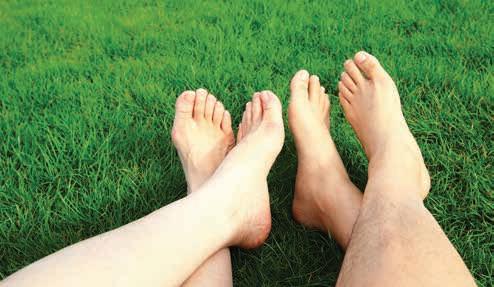
5 minute read
GREENER GREEN GRASS
Greener Green Grass Why Organic Lawns Make Eco-Sense

Advertisement
by Julie Peterson
With its dependence on synthetic government agencies. Th e Pesticide-Induced fertilizers and pesticides, Diseases database at BeyondPesticides.org America’s 63,000 square miles holds myriad studies linking chemicals to of lawns rely on fossil fuels, put pressure asthma, diabetes, autism, lupus, arthritis, on water supplies and devastate soil, waterParkinson’s disease, Alzheimer’s disease and sheds, animals and people. cancer. Children are particularly vulnerable Fortunately, green turf can be to the eff ects of toxins due to their developattained organically, with important ing organs. benefi ts. “In addition to protecting public Exposure to lawn chemicals also health, eliminating our use of pesticides comes through the air, on indoor surfaces and fertilizers will allow us to build and in water. A U.S. Geological Survey healthy soil and sequester more carbon report found pesticides in 99 percent of as we face climate chaos,” says Mackenzie urban streams. In mixed land use areas, Feldman, executive director of Herbicide100 percent of major rivers and 33 percent Free Campus, a San Francisco organizaof major aquifers were tainted. tion working to transition colleges nation While the culture around the aeswide to organic lawns. thetics of landscapes is strong, the tipping point has arrived. Th e Harm Done “People are becoming more aware Homeowner desire for lush swaths of that their children are at elevated risk monoculture grass has been fueled by lawn and that there are defi ciencies in the laws chemical ads equating model families with that govern toxic chemical use,” says Jay fl awless lawns. Unfortunately, the “green Feldman, executive director of Beyond grass of home” isn’t an ideal dream, it’s a Pesticides, in Washington, D.C. nightmare. Research shows that it exposes Lawn chemicals are also feeding people to cancer-causing, reproductiveclimate change. “Not only are they fossilharming and endocrine-disrupting chemifuel intensive to produce, they harm the cals, many of which are deemed safe by biology in the soil and destroy its ability to sequester carbon,” says Diana Carpinone, president of Non Toxic Communities, a pesticide reform nonprofi t, and founder of Non Toxic Dover, in New Hampshire.
Front Yard Activists
Recent lawsuits and climate change have given activists more power to eff ect sweeping changes in policy. “Th is isn’t just a niche idea. We have a mandate, given looming environmental crises, to transform our current chemical intensive systems to organic,” says Jay Feldman. Organic turf experts have devised methods to grow monoculture grass. According to Ryan Anderson, a community outreach specialist at the Integrated Pest Management Institute of North America and leader of Midwest Grows Green, “Homeowners can keep their lawns organic by increasing cultural controls.” Th ese include aerating, over seeding and mowing high to build the soil, turf and plant system. While pristine lawns are possible, reconsidering aesthetics is another option. “We could let native plants grow and embrace plant diversity as fundamental to ecosystem resilience,” says Mackenzie Feldman. Indeed, “weeds” are benefi cial. Clover feeds nitrogen to grass, benefi ts soil organisms and stays green long aft er turf. Dandelions were once considered a source of food and medicine, and all parts of it are edible, including fl owers, roots and leaves. Instead of living with weeds, some homeowners are choosing to tear out lawns and put in indigenous plants to attract pollinators and other wildlife. But it takes time for society to adopt new views and front yards can be polarizing. “You can’t go from zero to hippie in a day. People need realistic goals,” says Carpinone. Whether someone rents, owns or only has access to shared green spaces, Shaina Rico, founder of Th e Generation Ground, an Austin-based organization helping farmers launch regenerative businesses, feels everyone must “take ownership of our green spaces. If you are not the one managing the land, ask questions of those
that are. What are we doing to support the soil biology? Can we achieve the goal without using chemicals? How can we increase soil organic matter?”
Greener Communities
Concerned citizens are asking local governments and school districts to eliminate chemical turf management protocols at parks and schools. Nonprofit campaigns such as Beyond Pesticides, Non Toxic Communities and Herbicide-Free Campus can sometimes send a spokesperson and provide ample data to overcome common objections. “We can show that organic is viable and economical. Organic systems end up reducing costs over time,” says Jay Feldman, who helps install community pilot sites. Transitioning to organic practices requires a focus on soil health, building up microbial life and organic matter, understanding the ecosystem and creating a balanced ecology. Once in place, it’s a functioning system that doesn’t need much management. “You can have a beautiful, organic, green lawn that’s safe for all living things,” says Carpinone.

Julie Peterson writes about wellness and environmental issues from rural Wisconsin. Reach her at JuliePeterson2222@gmail.com.

Off set climate change and improve health for people and the planet by reaching out to the community or fi nding helpful experts to assist with local eff orts. Non Toxic Communities (NonToxicCommunities.com) off ers resources to create healthier schools, lawns and landscapes throughout the country. Beyond Pesticides (BeyondPesticides.org) has a database of pest management and lawn service companies that don’t use dangerous pesticides, lawn signs for the organic yard and a sign-up for Th e Action of the Week to contact elected offi cials about current issues.
Th e Integrated Pest Management Institute of North America
(ipminstitute.org) provides low-risk pest management solutions for farms, greenhouses, facilities and homes. Herbicide-Free Campus (HerbicideFreeCampus.org) is working to transition every campus in the country to organic. Th e Great Healthy Yard Project (tghyp.com/downloads) has downloads on how to grow without gunk and encouraging others to do the same.
Are you using antibiotics, steroids or anti-fungals to treat a respiratory infection? Still sick and feeling worse?



We use a natural, laboratory and clinically proven antimicrobial that kills bacteria, fungus and virus without harming the patient.
We use RESPIRATORY RELIEF from
20%OFF with coupon code RESP20


We get calls & orders from people who have tried all sorts of prescription medications that do NOT get rid of their respiratory infections. Time after time the infections clear up in a few days with Respiratory Relief. We shake our heads and wonder, “Why don’t they try this first?” Now you can. For use in a nebulizer







